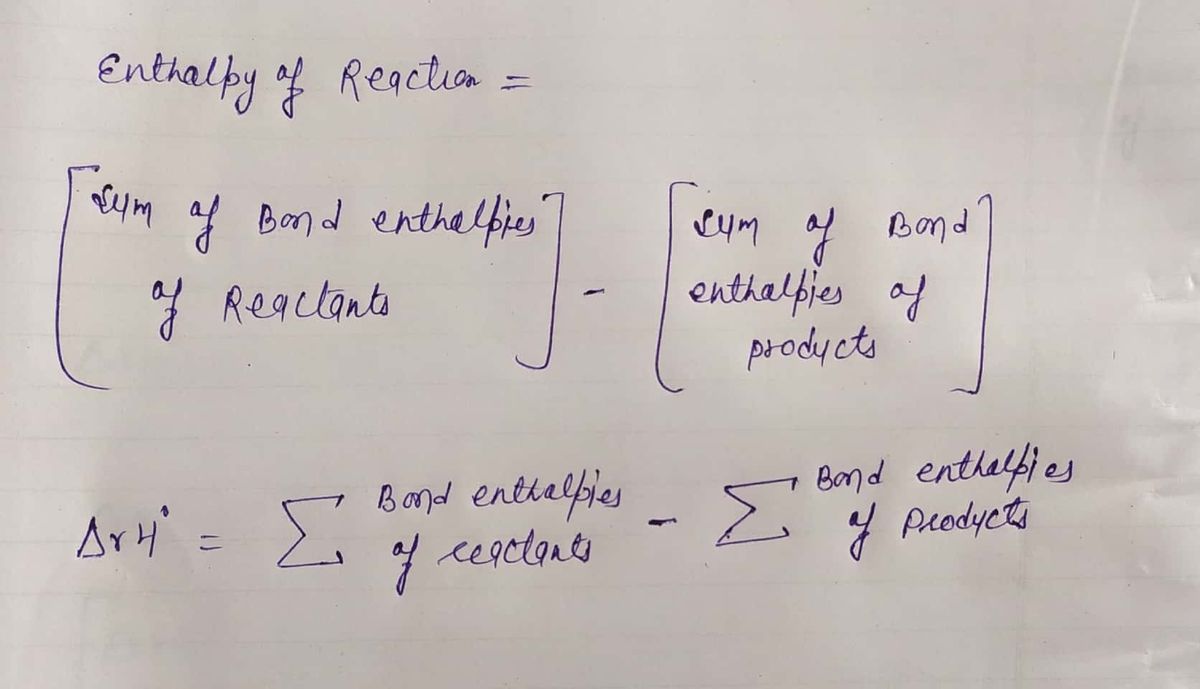What is the enthapy of the reaction of C2H4O + H2 ---> C2H6O in kJ a. -484kJ b. -366kJ c. -48kJ d. 48 kJ e. 366 kJ Please see attached image for structure and bond energies given in problem
Thermochemistry
Thermochemistry can be considered as a branch of thermodynamics that deals with the connections between warmth, work, and various types of energy, formed because of different synthetic and actual cycles. Thermochemistry describes the energy changes that occur as a result of reactions or chemical changes in a substance.
Exergonic Reaction
The term exergonic is derived from the Greek word in which ‘ergon’ means work and exergonic means ‘work outside’. Exergonic reactions releases work energy. Exergonic reactions are different from exothermic reactions, the one that releases only heat energy during the course of the reaction. So, exothermic reaction is one type of exergonic reaction. Exergonic reaction releases work energy in different forms like heat, light or sound. For example, a glow stick releases light making that an exergonic reaction and not an exothermic reaction since no heat is released. Even endothermic reactions at very high temperature are exergonic.
What is the enthapy of the reaction of
C2H4O + H2 ---> C2H6O
in kJ
a. -484kJ b. -366kJ c. -48kJ d. 48 kJ e. 366 kJ
Please see attached image for structure and bond energies given in problem
![### Reaction:
The chemical equation depicted is:
\[
\text{CH}_3\text{CHO} (g) + \text{H}_2 (g) \rightarrow \text{CH}_3\text{CH}_2\text{OH}
\]
### Bond Energy Table:
The table shows the bond energies in kilojoules per mole (kJ/mol) for various chemical bonds:
- \(\text{C=O}\): 745 kJ/mol
- \(\text{H-H}\): 436 kJ/mol
- \(\text{C-H}\): 414 kJ/mol
- \(\text{O-H}\): 464 kJ/mol
- \(\text{C-C}\): 347 kJ/mol
- \(\text{C-O}\): 351 kJ/mol
### Options for Reaction Enthalpy Change:
The possible enthalpy changes (ΔH) for the reaction are provided as multiple-choice options:
- a. -484 kJ
- a. -366 kJ
- a. -48 kJ
- a. +48 kJ
- a. +366 kJ
This information can be used to calculate the enthalpy change of the reaction based on bond energies.](/v2/_next/image?url=https%3A%2F%2Fcontent.bartleby.com%2Fqna-images%2Fquestion%2Fd5015106-388e-4d6b-8592-fff9867f652a%2Fef2479fb-a46d-4ec5-8ad4-eb8d543f4568%2Fqhleinr_processed.jpeg&w=3840&q=75)

Trending now
This is a popular solution!
Step by step
Solved in 2 steps with 2 images









